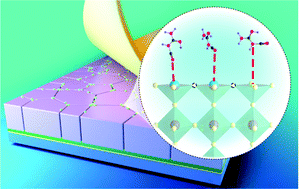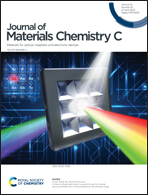Deep level defects passivated by small molecules for the enhanced efficiency and stability of inverted perovskite solar cells†
Abstract
Perovskite solar cells (PSCs) suffer from deep level defects which would cause charge accumulation and consequent non-radiative recombination losses during the operation of the device, limiting their power conversion efficiencies (PCEs). Herein, we employ small molecule dicyandiamide (DICY) as a passivating agent for the deep level defects of perovskite thin films. The C–N bond (C–NH–C) of DICY is found to be Lewis acidic due to the inductive effect of Lewis basic imine (–C![[double bond, length as m-dash]](https://www.rsc.org/images/entities/char_e001.gif) N) and cyano (–C
N) and cyano (–C![[triple bond, length as m-dash]](https://www.rsc.org/images/entities/char_e002.gif) N) functional groups of DICY. So, the synergistic effect of the functional groups in DICY could passivate the deep level defects by forming a Lewis adduct by coordination bonds, which is proved by density functional theory calculations and SCLC measurements. The elimination of the deep level defects of perovskite thin films results in a reduced charge recombination and more efficient charge transport. Consequently, the optimized PSC based on DICY shows a champion PCE of 20.05%. Our findings reveal the mechanisms of the synergistic effect of the functional groups in the small molecule on passivating the deep level defects of perovskites.
N) functional groups of DICY. So, the synergistic effect of the functional groups in DICY could passivate the deep level defects by forming a Lewis adduct by coordination bonds, which is proved by density functional theory calculations and SCLC measurements. The elimination of the deep level defects of perovskite thin films results in a reduced charge recombination and more efficient charge transport. Consequently, the optimized PSC based on DICY shows a champion PCE of 20.05%. Our findings reveal the mechanisms of the synergistic effect of the functional groups in the small molecule on passivating the deep level defects of perovskites.



 Please wait while we load your content...
Please wait while we load your content...